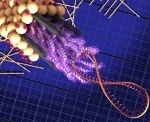Through harnessing viruses as workers, MIT researchers have developed a method of improving the conversion efficiency of solar cells.
While the incorporation of tiny carbon nanotubes in a solar cell’s structure can improve the cell’s power conversion efficiency, arranging the nanotubes appropriately has been quite a challenge due to varying nanotube properties and the tendency for them to bundle together.
Using a genetically engineered version of a virus called M13, the researchers found the arrangement of the nanotubes can be controlled to ensure circuits aren’t shorted out and the tubes don’t clump together. The result is a power conversion efficiency improvement of around a third, while only increasing the cell’s weight by a tenth of a percent.
The tests were carried out on dye-sensitised solar cells, but the researchers say the same technique could be applied to other solar cell technologies also, including quantum-dot and organic solar cells.
Dye-sensitised solar cells have had limited uptake in several countries to date, but with the significant boost offered by the added virus technology, these types of solar cells may become more popular.
According to Angela Belcher, the W. M. Keck Professor of Energy, as the process would only add a single step to current standard solar-cell manufacturing; it should be viable to adapt existing production facilities rapidly. The viruses create nanotubes that are soluble in water, so they can be incorporated into the solar cell using a water-based process at room temperature.
This breakthrough development isn’t the first time a virus has been utilised in connection with renewable energy related technology. Researchers at the University of Maryland’s A. James Clark School of Engineering and College of Agriculture and Natural Resources last year began utilising the tobacco virus to create a new generation of highly efficient batteries that will offer ten times the energy capacity standard lithium ion battery.
In 2009, MIT researchers demonstrated the ability to genetically engineer viruses to construct lithium-ion battery anodes.
Source/Image source







































